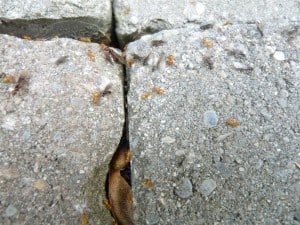
Large, winged female (to left of crack at top); small winged males; wingless, reddish workers – Sept. 10, 2013
Yesterday, I was provided with an intriguing glimpse into the lives of ants. So-called “flying ants” were milling about on our front steps and flying overhead in the backyard. Ants only have wings during the mating phase of their life cycle. Mating takes place over the course of just one day in a phenomenon known as swarming. Swarming behaviour most often occurs in the afternoon or early evening, usually a day or so after a heavy rain, when the weather is warm and humid. This was certainly the case of the weather yesterday, with temperatures around 30 C.
I was able to see hundreds of winged males, along with smaller numbers of larger winged females, emerging from the cracks between the bricks in the steps. They were being pushed out of the cracks by reddish, wingless workers. In a swarm, male ants are attracted to powerful sex pheromones produced by the female. Copulation often occurs on the wing and these future queen ants will mate with several males. Swarming behaviour is usually synchronized with other ant colonies of the same species so that it occurs on the exact same day over a large area and promotes interbreeding.
An especially interesting behaviour of mating swarms in some species is known as “hilltopping.” In what is probably an effort to more easily find a mate, ants congregate around prominent points of a landscape such as a large tree or a chimney. When ants are swarming, it is not uncommon to see predators such as dragonflies or even Ring-billed Gulls grabbing the ants out of mid-air and quickly gobbling them up. When the swarming ceases, all of the male ants die, and each mated female begins the very difficult task of establishing her own new colony. The first thing she does is to shed her new wings by biting them off. You can often see wings lying about after swarming has occurred. The wing muscles, which are no longer needed for flight, become an important source of nutrients during the initial stages of colony development.
Most of the ants we commonly see in central Ontario are formicine ants belonging to the genus Formica. They are typically black or black and red and are often seen on sidewalks. Formicine ants have a distinctive node (prominent “bump”) on the constricted waist between the thorax and the abdomen. However, you can only see it well with a good hand lens. Another way to identify them is to simply pick up one or two. You should be able to get a good whiff of formic acid. I was certainly able to smell it yesterday. This chemical serves a number of purposes ranging from communication to defense. One of the most common formicine ants is the black carpenter ant. They are infamous for sometimes damaging wood structures when excavating nests.
Drew Monkman